Motor On A Hall Effect Switch
Difficulty level: 2 (simple, but requires the use of a soldering iron)
Kits covered: Kits #6,8
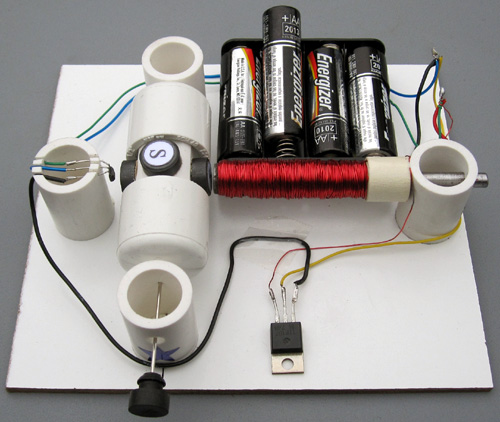
This is a simple and probably the most reliable motor. You may take a look at how easy it is to
assemble this motor from the kit.
In 1879 Edward Hall placed a thin layer of gold in a strong magnetic field. He
connected a battery to the opposite sides of this film and measured the current
flowing through it. He discovered that a small voltage appeared across this film.
This voltage was proportional to the strength of magnetic field multiplied by the
current. This effect bears his name.
For many years the Hall effect
was not used in practical applications because the generated voltage in the gold
film was extremely low. However, in the second half of the 20th century the mass
production of semiconductor chips started. Chips based on the Hall effect became
inexpensive and widely available.
The Hall effect IC (integrated
circuit) is a very small chip which includes many transistors. It consists of a
thin layer of silicon as a Hall generator (which works better than gold) and
several transistor circuits: to amplify the Hall voltage to a necessary level;
to trigger output voltage with its growth; and to provide stable work regardless
of the power supply voltage changes. The picture below demonstrates the Hall
effect IC:
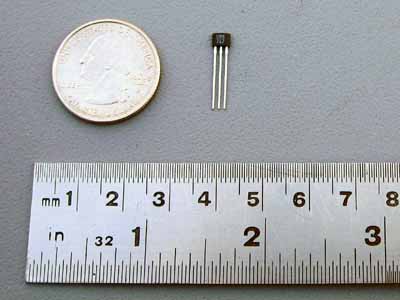
The Hall effect IC is a solid
state electronic device with no mechanical parts and therefore it is more
reliable than a reed switch. To no surprise it is now the most widely used
sensor in industrial brushless motors. Normally, however, they include a lot of
other components. Stan designed a motor on a Hall effect switch with minimum
parts based on the same unified mechanical design and it worked very well.
The Hall effect IC used in Kits 6
and 8 (or available as a separate part) is a unipolar switch. It turns on and
off when the South pole of the magnet passes by its branded side. The North pole
has no effect on it, unless it approaches from the back side of the Hall IC.
This Hall effect IC has a built in voltage regulator and may work in the range
from 4.5 to 24V. The Hall effect IC's included in the kit, however, were tested
extensively; and it was found that most of them start working at 3V. This is a
typical Hall effect IC shown from the branded side:
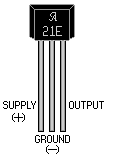
The Hall effect switch output
current is not sufficient to power this motor, therefore it also requires a
power transistor. You may find information on this component at How It Works: Reed Switch Motor With A Transistor.
This is how this motor works:
- When magnet #1 gets close to the Hall IC, the sensor sends a signal to the base of the power transistor. The transistor opens, and allows a bigger collector current to flow through the electromagnet. The electromagnet pushes magnet #3 away.
- When the rotor spins away, magnet #1 stops affecting the Hall IC. Since the signal to the base of the power transistor has been removed, it is turned off. This disables the electromagnet.
- The rotor continues to spin due to inertia until magnet #2 moves into the working range of the Hall IC. The Hall IC sends a signal to the base of the transistor. The transistor opens, and allows a bigger collector current to flow through the electromagnet. The electromagnet pushes magnet #4 away. This process continues until the power is disconnected.
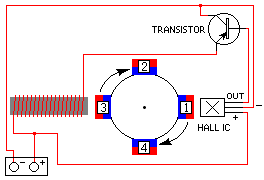
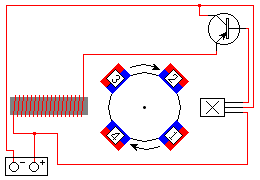
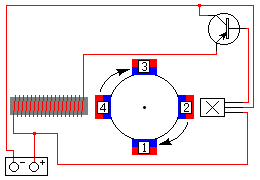
This motor can be
built from Kit #6. Complete instructions
are provided. However, if you decide to design this motor yourself, you may order only the parts you
need (Hall effect IC, PNP power transistor, magnet wire, magnets, heat sink).
Our experiments showed that the
speed of this motor could be controlled by an extra magnet the same way the
speed control unit works for the reed switch motors (see Assembly Instructions: Experimentation Kit #1 and
How It Works: Reed Switch Motor). The magnetic field of the additional magnet
placed near the Hall effect IC interacts with the magnetic field of the magnets
on the rotor. As you move this additional magnet the combined magnetic field
becomes stronger or weaker depending on the orientation of the speed control
magnet. It affects the time the Hall sensor sends the signal to the transistor
and therefore changes the motor speed. You may buy a speed control unit or just an
additional magnet at our ordering page.